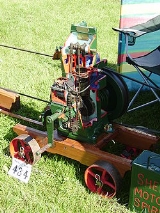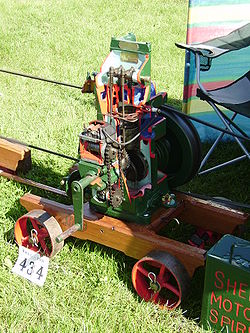
R A Lister and Company
Encyclopedia

Dursley
Dursley is a market town in Gloucestershire, England. It is under the North East flank of Stinchcombe Hill , and about 6 km South East of the River Severn. The town is adjacent with Cam which, though a village, is a community of double the size...
, Gloucestershire, in 1867 by Sir Robert Ashton Lister (1845–1929), to produce agricultural machinery. The family was originally from Yorkshire
Yorkshire
Yorkshire is a historic county of northern England and the largest in the United Kingdom. Because of its great size in comparison to other English counties, functions have been increasingly undertaken over time by its subdivisions, which have also been subject to periodic reform...
but Ashton's father (George Lister) relocated to Dursley
Dursley
Dursley is a market town in Gloucestershire, England. It is under the North East flank of Stinchcombe Hill , and about 6 km South East of the River Severn. The town is adjacent with Cam which, though a village, is a community of double the size...
in 1817.
History
Founded in 1867, R. A. Lister and Co. were initially manufacturers of agricultural equipment, but after the invention of the internal combustion engine the company became a world-renowned name in engineering. By the early 20th century Listers were producing petrol engines, initially to power sheep-shearing equipment. These products remained an important part of the company's business, but over time the product range expanded considerably, ranging from electric lighting plants and dairy equipment to garden furniture.Robert Ashton Lister was still alive in the late 1920s, at which time the management of the firm had passed to younger members of his family. In 1926 the chairman of the board was Austin Lister, and the company was run by the five sons of Austin's brother Charles: Robert, George, Percy, Frank and Cecil. Inevitably this occasionally caused tensions, as for example George managed home sales and Frank was in charge of buying, while Cecil did not have a clearly defined role at all; and, although Robert was the eldest, it was Percy (later Sir Percy) who had by far the most significant impact.
As managing director Percy led the firm through a period of significant growth and prosperity in the 1920s and 1930s. By 1926 the workforce was around 2000 and was growing rapidly; the company ran a 24-hour manufacturing operation, expanding its range of products and supplying retailers to around 6000 UK customers and many more worldwide. Retailing revenues were particularly healthy in Australia and New Zealand, where sheep-shearing equipment was in great demand.
The company headquarters were housed in an early 16th-century Priory building in Dursley (which remained the headquarters of Lister Petter at time of writing in 2009). In the nearby valley was located a foundry, together with a number of other workshops necessary for the production of engines and the various other products offered, including a machining shop, capstan lathe shop, engine assembly lines, and a coopers' shop.
Lister engines were traditionally painted a mid-range shade of Brunswick Green, which continues to be used by Lister Petter (see below) at time of writing (2009). In 1929, the first of Lister's own design of "CS" (cold start) diesel engine was made in Dursley
Dursley
Dursley is a market town in Gloucestershire, England. It is under the North East flank of Stinchcombe Hill , and about 6 km South East of the River Severn. The town is adjacent with Cam which, though a village, is a community of double the size...
. The CS is a slow-running (600 rpm), reliable engine, suitable for driving electric generators or irrigation
Irrigation
Irrigation may be defined as the science of artificial application of water to the land or soil. It is used to assist in the growing of agricultural crops, maintenance of landscapes, and revegetation of disturbed soils in dry areas and during periods of inadequate rainfall...
pumps. The CS type engines (the range spanned single-, twin-, triple- and four-cylinder versions in a range of power outputs) gained a reputation for longevity and reliability, especially in Commonwealth
Commonwealth of Nations
The Commonwealth of Nations, normally referred to as the Commonwealth and formerly known as the British Commonwealth, is an intergovernmental organisation of fifty-four independent member states...
countries, to which they were widely exported. Some CS engines ran practically continuously for decades in agricultural, industrial and electrical applications.
By around 1930 Listers were producing around 600 engines a week, most of which were small at around 1.5 to 3 hp; many of these had applications in the construction industry. Listers continued to flourish during the 1930s, riding the economic financial crisis and building on its many earlier successes.
The most successful Lister engine was the Lister 'D' type engine, most of which were 1.5 horsepower
Horsepower
Horsepower is the name of several units of measurement of power. The most common definitions equal between 735.5 and 750 watts.Horsepower was originally defined to compare the output of steam engines with the power of draft horses in continuous operation. The unit was widely adopted to measure the...
/ 700 RPM units. Over 250,000 'D' engines were built between 1926 and 1964, and were used for a wide variety of light tasks such as pumping and small-scale electricity generation. The Lister 'D' is still one of the most widely seen vintage stationary engines in the UK. Unauthorized copycat engines ("Listeroids") have also been produced in other countries.
Having survived the Second World War, Listers continued to benefit from its reputation for durable, reliable high-quality engines, and its pedigree as an old-established firm. However labour costs in the post-war period made a return to the heyday of the 1920s and 1930s impossible. Competition from rivals such as Petter, and from overseas were also factors to be contended with, and in 1965 Listers was acquired by Hawker-Siddeley (see below) who had also bought its old rival Petter in 1957.
Hand-cranked Lister diesel engines were used in many early dumper
Dumper
A dumper is a vehicle designed for carrying bulk material, often on building sites. Dumpers are distinguished from dump trucks by configuration: a dumper is usually an open 4-wheeled vehicle with the load skip in front of the driver, while a dump truck has its cab in front of the load. The skip can...
s.
In 1986 Hawker-Siddeley merged the two engineering concerns to form a new company, Lister-Petter, which was now placed to build on the strengths of both its predecessors. The economic climate of the 1980s and 90s, however, led to a change in the company's fortunes, and Hawker-Siddeley had to sell out. An unstable period followed, and, having narrowly escaped collapse, the company was split; part was acquired by Deutz but the core part of the business was bought out by venture capital investors who began to rebuild its product range.
In the early years of the 21st century, as in previous decades, small, durable, reliable industrial and marine engines continued to be a staple, notably the ALPHA water-cooled industrial and marine engines (2-, 3- or 4-cylinder) and the "T" air-cooled series (1-, 2- or 3-cylinder). Although Lister-Petter no longer ran a foundry, engines and diesel generating sets continued to be assembled and sold from a factory on the original site in Dursley. The new investors began to extend the product range to include more powerful engines and a wider range of generating set specifications. In 2007 a new heavy-duty engine, the OMEGA, offering up to 268 kW, was added to the company's product range.
In 2007 Lister Petter held an exhibition in Dursley to mark its 140th anniversary, which included a group photo of staff on the 60th anniversary in 1927. Listers has always had strong family traditions, and one employee who attended this 2007 exhibition was able to identify both her maternal grandparents in the 1927 photo.
In 2009 Lister Shearing (now a separate company) celebrated its centenary.
Mergers
Lister took over Blackstone & CoBlackstone & Co
Blackstone & Co. was a farm implement maker at Stamford, Lincolnshire, England. In 1896 they built lamp start oil engines. By 1912 they had developed a new diesel engine that ran on vaporizing oil and was fired by a spark...
in 1937 to form Lister Blackstone .
R A Lister & Company was taken over by the Hawker Siddeley Group in 1965, and merged in 1986 with Petter Diesels
Petters Limited
Petters Limited , were a maker of stationary petrol and diesel engines from 1896 onwards.In 1915 Petter founded Westland Aircraft Works ....
to form Lister-Petter Ltd.
The supply of remanufactured Lister engines and parts
Although R A Lister ceased production of many of its well known models many years ago, many of these engine are still in use today all over the world. Two of the most prominent suppliers of parts and services for these engine in the UK are Sleeman & Hawken Ltd and Marine Engine Services Ltd. Another firm, Marine Power Services specialise in the restoration and marinisation of Lister engines for the inland waterways and the manufacture of component castings including Lister JP marine exhaust and water system manifolds.Listeroid engines
Production of CS engines in EnglandEngland
England is a country that is part of the United Kingdom. It shares land borders with Scotland to the north and Wales to the west; the Irish Sea is to the north west, the Celtic Sea to the south west, with the North Sea to the east and the English Channel to the south separating it from continental...
ended in 1987 but the popularity and reputation of the design meant that a number of India
India
India , officially the Republic of India , is a country in South Asia. It is the seventh-largest country by geographical area, the second-most populous country with over 1.2 billion people, and the most populous democracy in the world...
n manufacturers have since continued production of "Listeroids" or clones copied from the CS design. These engines are used in India
India
India , officially the Republic of India , is a country in South Asia. It is the seventh-largest country by geographical area, the second-most populous country with over 1.2 billion people, and the most populous democracy in the world...
and also exported to other countries, including Australia
Australia
Australia , officially the Commonwealth of Australia, is a country in the Southern Hemisphere comprising the mainland of the Australian continent, the island of Tasmania, and numerous smaller islands in the Indian and Pacific Oceans. It is the world's sixth-largest country by total area...
and the USA. Recently there has been an upsurge in interest in these engines and their unique capabilities for long-term electrical generation or pumping, and the initially haphazard build quality of "Listeroids" had now largely reached the same level as the original Lister-built units. They are becoming increasingly popular for "off grid" or "remote" uses, partially because of their ability to use a large variety of alternate fuels and ease of maintenance and repair. Indian companies have also taken out licenses on Petter diesel engines (naturally dubbed 'Petteroids'), as well as other Lister (and latterly Lister-Petter) designs, such as Indian-built versions of the air-cooled L-Series diesel engines.

